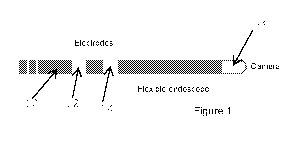Some of the information on this Web page has been provided by external sources. The Government of Canada is not responsible for the accuracy, reliability or currency of the information supplied by external sources. Users wishing to rely upon this information should consult directly with the source of the information. Content provided by external sources is not subject to official languages, privacy and accessibility requirements.
Any discrepancies in the text and image of the Claims and Abstract are due to differing posting times. Text of the Claims and Abstract are posted:
| (12) Patent Application: | (11) CA 3025603 |
|---|---|
| (54) English Title: | DEVICE FOR TREATMENT OF DYSPHAGIA |
| (54) French Title: | DISPOSITIF POUR LE TRAITEMENT DE LA DYSPHAGIE |
| Status: | Deemed Abandoned |
| (51) International Patent Classification (IPC): |
|
|---|---|
| (72) Inventors : |
|
| (73) Owners : |
|
| (71) Applicants : |
|
| (74) Agent: | SMART & BIGGAR LP |
| (74) Associate agent: | |
| (45) Issued: | |
| (86) PCT Filing Date: | 2017-05-25 |
| (87) Open to Public Inspection: | 2017-11-30 |
| Examination requested: | 2022-05-25 |
| Availability of licence: | N/A |
| Dedicated to the Public: | N/A |
| (25) Language of filing: | English |
| Patent Cooperation Treaty (PCT): | Yes |
|---|---|
| (86) PCT Filing Number: | PCT/GB2017/051482 |
| (87) International Publication Number: | WO 2017203263 |
| (85) National Entry: | 2018-11-26 |
| (30) Application Priority Data: | ||||||
|---|---|---|---|---|---|---|
|
The present invention defines a device for the treatment of dysphagia comprising a flexible member mounting an imaging device for insertion into a patient and one or more electrodes proximate the imaging device for imparting electrical stimulation to the patient.
La présente invention concerne un dispositif pour le traitement de la dysphagie qui comprend un élément flexible sur lequel est monté un dispositif d'imagerie à insérer dans le corps d'un patient et une ou plusieurs électrodes à proximité du dispositif d'imagerie pour appliquer une stimulation électrique au patient.
Note: Claims are shown in the official language in which they were submitted.
Note: Descriptions are shown in the official language in which they were submitted.

2024-08-01:As part of the Next Generation Patents (NGP) transition, the Canadian Patents Database (CPD) now contains a more detailed Event History, which replicates the Event Log of our new back-office solution.
Please note that "Inactive:" events refers to events no longer in use in our new back-office solution.
For a clearer understanding of the status of the application/patent presented on this page, the site Disclaimer , as well as the definitions for Patent , Event History , Maintenance Fee and Payment History should be consulted.
| Description | Date |
|---|---|
| Deemed Abandoned - Conditions for Grant Determined Not Compliant | 2024-09-13 |
| Letter Sent | 2024-03-19 |
| Notice of Allowance is Issued | 2024-03-19 |
| Inactive: Approved for allowance (AFA) | 2024-03-15 |
| Inactive: Q2 passed | 2024-03-15 |
| Amendment Received - Voluntary Amendment | 2023-11-01 |
| Amendment Received - Response to Examiner's Requisition | 2023-11-01 |
| Examiner's Report | 2023-07-04 |
| Inactive: Report - No QC | 2023-06-08 |
| Letter Sent | 2022-06-28 |
| Inactive: Submission of Prior Art | 2022-06-28 |
| Request for Examination Received | 2022-05-25 |
| All Requirements for Examination Determined Compliant | 2022-05-25 |
| Request for Examination Requirements Determined Compliant | 2022-05-25 |
| Common Representative Appointed | 2020-11-07 |
| Common Representative Appointed | 2019-10-30 |
| Common Representative Appointed | 2019-10-30 |
| Amendment Received - Voluntary Amendment | 2018-12-11 |
| Inactive: Notice - National entry - No RFE | 2018-12-06 |
| Inactive: Cover page published | 2018-12-03 |
| Application Received - PCT | 2018-11-30 |
| Inactive: IPC assigned | 2018-11-30 |
| Inactive: IPC assigned | 2018-11-30 |
| Inactive: IPC assigned | 2018-11-30 |
| Inactive: First IPC assigned | 2018-11-30 |
| National Entry Requirements Determined Compliant | 2018-11-26 |
| Application Published (Open to Public Inspection) | 2017-11-30 |
| Abandonment Date | Reason | Reinstatement Date |
|---|---|---|
| 2024-09-13 |
The last payment was received on 2024-05-13
Note : If the full payment has not been received on or before the date indicated, a further fee may be required which may be one of the following
Please refer to the CIPO Patent Fees web page to see all current fee amounts.
| Fee Type | Anniversary Year | Due Date | Paid Date |
|---|---|---|---|
| Basic national fee - standard | 2018-11-26 | ||
| MF (application, 2nd anniv.) - standard | 02 | 2019-05-27 | 2019-04-24 |
| MF (application, 3rd anniv.) - standard | 03 | 2020-05-25 | 2020-05-11 |
| MF (application, 4th anniv.) - standard | 04 | 2021-05-25 | 2021-05-17 |
| MF (application, 5th anniv.) - standard | 05 | 2022-05-25 | 2022-05-19 |
| Request for examination - standard | 2022-05-25 | 2022-05-25 | |
| MF (application, 6th anniv.) - standard | 06 | 2023-05-25 | 2023-05-25 |
| MF (application, 7th anniv.) - standard | 07 | 2024-05-27 | 2024-05-13 |
Note: Records showing the ownership history in alphabetical order.
| Current Owners on Record |
|---|
| PHAGENESIS LIMITED |
| Past Owners on Record |
|---|
| CONOR MULROONEY |